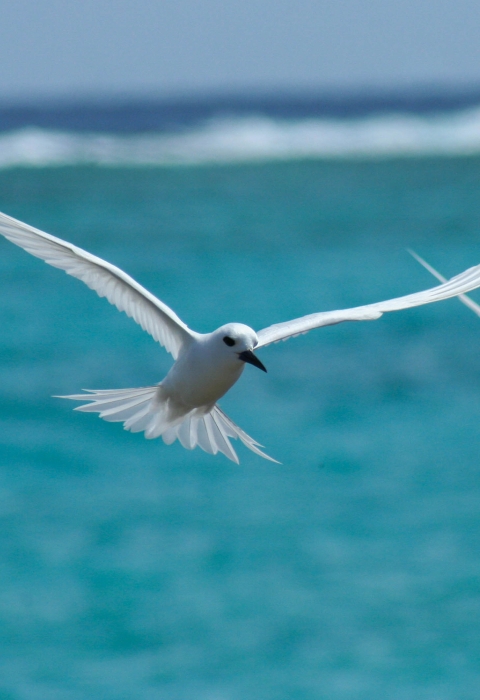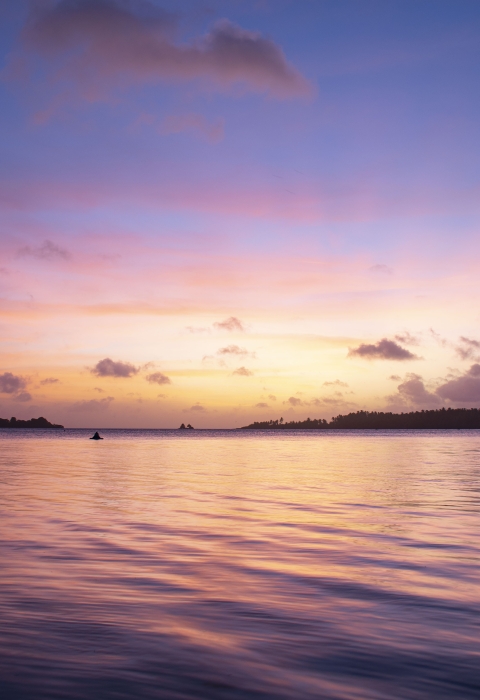About Us
The Pacific Remote Islands Marine National Monument was established on January 6, 2009, by President George W. Bush under the authority of the Antiquities Act of 1906, but expanded to its current size on September 25, 2014, by President Barack Obama. It is one of five Marine National Monuments managed in partnership by the Service, including four Marine National Monuments in the Pacific. The Monument encompasses approximately 495,189 square miles of open ocean, coral reef, and island habitats. For the areas surrounding Howland and Baker Islands, Kingman Reef, and Palmyra Atoll National Wildlife Refuge, the Monument extends protections out to 50 nautical miles from the refuges shorelines. In the case of Jarvis Island, and Johnston and Wake Atoll National Wildlife Refuge, the protections extend to 200 nautical miles from the refuges shorelines.
Presidential Proclamation 8336 established the Monument, giving the Secretary of the Interior management responsibility for it, in consultation with the Secretary of Commerce. Presidential Proclamation 9173 expanded the Monument around Jarvis Island and Johnston and Wake Atolls to include seamounts and deep ocean features important to scientific exploration, study, and research.
The Secretary of Defense continues to manage Wake Atoll under a 1972 agreement with the Department of the Interior. Similarly, the Department of Defense continues to have administrative jurisdiction over terrestrial portions of Johnston Atoll until jurisdiction is returned to the Department of the Interior.
Both the Proclamations prohibit commercial fishing within the monument, but gives the Secretary of Commerce (in consultation with the Secretary of Interior), through NOAA, primary responsibility for managing fishery-related activities from 12 to 50 or 200 nautical miles from the islands.
Our Mission
Protecting entire ecosystems is vital for the species that depend on the ocean - from trees and crabs to coral, to marine mammals, green sea turtles, to seabirds and people. The purpose of the Monument is to provide protection to all waters and submerged and emergent lands owned and controlled by the Government of the U.S. and resources in its boundaries. Our mission is to provide stability and protection to the Monument, allowing plants, wildlife, and marine life a refuge to thrive.
The Proclamations establishing the Monument require the Secretaries of the Interior and Commerce, who delegated management responsibilities to the Service and the NOAA to prepare a Monument Management Plan within their respective authorities for the Monument, and to promulgate implementing regulations that address specific actions necessary for the proper care and management of the Monument. With this notice, the Department of the Interior and Department of Commerce commit to working cooperatively together and with partners and stakeholders in the development of the MMP.
Our History
The history within the Pacific Remote Islands Marine National Monument is vast. Although Polynesians were the first visitors to many of the islands within the Monument, westerners “rediscovered” them in an uninhabited state as early as the 1820s.
Howland, Baker, and Jarvis Islands were claimed by the United States in 1856 under the Guano Act. A Story of the Hui Panalā‘au of the Equatorial Pacific Islands tells some of the heroic story of more than 130 "Colonists", enlisted from schools in Hawai'i before World War II, who helped consolidate the U.S. claim to the islands from 1935 until 1942.
The Colonists constructed settlements and served for months on the remote islands. They even prepared for aviators Amelia Earhart and Fred J. Noonan on their planned to stop over at Howland Island on their famous world circumnavigation flight in 1937. However, radio contact was lost after departing for Howland, and to this day their exact fate is unknown. The Amelia Earhart Day Beacon on Howland is named in her honor. In 1941, the Colonists were attacked several times following the attacks on Pearl Harbor. During the first wave of attacks, two young men on Howland, Joseph Keli‘ihananui and Richard “Dickey” Whaley, were fatally wounded. The remaining Hui members were rescued and returned to Hawai'i in 1942.
Johnston Atoll is an ancient atoll, and along with Wake Atoll, is probably the oldest in the Pacific Ocean. It is the northernmost of the Line Islands. Once claimed by both the United States and the Kingdom of Hawai‘i, the atoll was placed under control of the U.S. Navy in 1934. During World War II, it was an important aircraft and submarine refueling station; in 2004 the military mission ended and the base was dismantled, except for one facility.
Wake Atoll is the northernmost atoll in the Marshall Islands geological ridge and perhaps the oldest living atoll in the world. Used by ancestral Micronesian navigators, and later by a cable station and Pan American Airways, the atoll has been primarily used by the U.S. military since before World War II. During the war, it was the site of an history battle and was overtaken and occupied by Japanese soldiers from 1941-1945.
Part of the Line Islands chain, Palmyra Atoll and Kingman Reef are remnants of volcanoes from some 65-120 million years ago. Kingman is known to be the most undisturbed coral reef within the U.S., complete with a greater proportion of apex predators than at any other studied coral reef ecosystem in the world. Kingman Reef’s lagoon one was an overnight stop on the Pan American Airways clipper route. Palmyra hosted a 6,000-man Naval Air Station in World War II, complete with dock and airfield.

